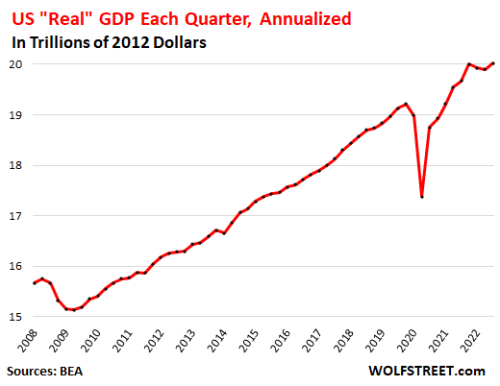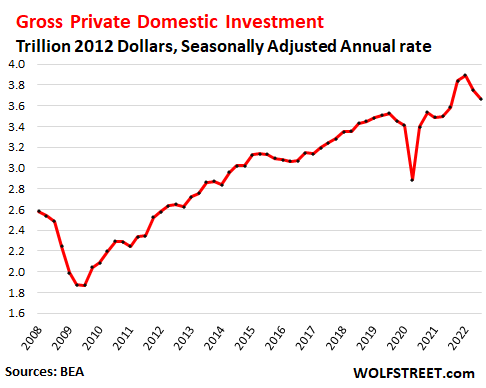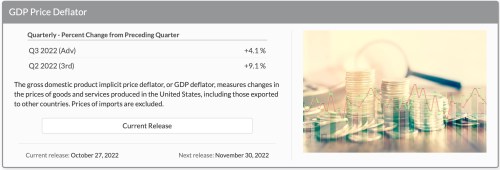President Bidin’-his-Time just got a little reprieve delivered right in time for the upcoming election, and it looks like we’re all having pork for Thanksgiving this year, not turkey. His government served up a nice GDP-growth surprise that came in below the Atlanta Fed’s final GDPNow estimate of 3.1% at 2.6%, but still a solid-looking porker of a non-recessionary number.
Glory, hallelujah! The president has plenty to give thanks for in this report because we all know Americans vote their pocket book and never re-elect the party in power during a recession. So, it’s important that we got that look of a recession out of the way, and this report put some serious lipstick on the pig.
Therefore, let’s look behind the makeup at what the headline number is really made of.
GDP looked good … but wasn’t as good as it looked due to [a] reversal of [a] Q1 “freak event.”
says Wolf Richter, and I agree.
The headline number means no recession … or does it?
In total terms (versus percentage growth or decline) GDP, in one move, returned exactly to its jumping off point at the start of the year.:
That little slump there, lasting more than one quarter, would have been called “a recession” in times past, whereas the smaller dips you see in 2012 and 2014, being only one-quarter long, would not.
If we go up from where total GDP sits now, the recession is over, if you are inclined to call it a “recession” as we boldly would have in the old days. You could say it is over now in that it has recovered; however, if it goes right back down again (making this quarter the fluke and not a move that held) then it would typically be called “a double-dip recession,” especially since it hasn’t recovered to a new high yet, but just to even.
However, no one calls anything as it is anymore — bad news is good news if you’re an investor; men are women; cats are mice … you know. So, I won’t hold my breath for that truthful declaration to be made, even if total GDP does go back down. Instead, those who declare these things are likely to side with the vast majority that stands far away from me, as though I apparently stink like a pig, myself. In which case, they will eventually say the entire past year was a fluke of Covid and the real recession began after the third quarter when GDP declined “for real” at last.
Government spending in a war-time economy appears to save the day
While I won’t hold my breath waiting for the government or even financial news to finally get honest and call this a recession, I will hold my nose around this pig. The bulk of the growth happened because,
after five months of declines, government consumption and investment rose again.
Yes, it was largely government pork that got fatter. Now, of course, that is the sector of GDP that the Democrats, who own Congress and the White House, fully control by decree since they can invent money to push it up by taking out debt the Fed will issue. That is particularly clear when you see what caused most of the increase in government spending in GDP: It was the war in Ukraine.
“National defense” — all those items bought for US national defense, which have been sent now as free gifts to Ukraine and surrounding NATO nations — was up twice as much as all other government spending — 4.7% v. 2.3%.
(Note that the government spending that is measured does not include salaries or payouts to people on the government dole (stimulus checks, unemployment, social security, etc.) because this is supposed to be an accounting of production by means of measuring purchases of goods and services, not the administrative cost of running government and not just money created out of thin air and passed along as money. The government checks that go to those at the government trough only become measured when they are spent on domestic goods and services so as not to be counted twice. The BEA measures what is spent on ALL goods and services, and then imports are subtracted back out because they shouldn’t be included in the first place under a measure of domestic production. As for the qualifier “domestic,” note that imports do not actually reduce GDP as often stated. Rather, they are baked into all GDP numbers as positives when the numbers are run and then subtracted out as lump sum based on port figures, etc. at the end.
In other words, to the extent you see them subtracted as a visible line item in any quarter, they were also added in that same quarter by being baked into all the other figures. So, their subtraction does nothing but wash them back out. For example, rather than try to subtract out the value of every imported part in a domestically produced automobile to get to the value of what was actually produced domestically, it is easier to add the FULL price of the automobile to GDP and then, after ALL GDP items are calculated, subtract all import valuations that came in through ports and across borders as listed on manifests that became declarations of value from the total, knowing those include all the imported car parts as well as every other kind of imported part included in all the other items initially counted as gross domestic production.)
Private investment actually plunged by a massive 8.5% as adjusted for inflation, and would have plunged by more if real inflation were used, but it wasn’t (which I’ll come to). Investment in non-residential buildings was down 15.3% while investment in housing (not surprising, given the real-estate crash) was down 26.4%!
That looks like this now that the total Fed-fueled Covid housing boom has gone bust:
Another major driver in the GDP boost was fossil fuels. All those exports that are suddenly heading off to Europe to make up for the shortages there due to wartime sanctions have been making US energy companies extremely profitable. Prices are way up (hold it, isn’t that part inflation?), and volume is way up. so exports surged 14.4%, a good part of which was due to fuels. In fact, net exports (what you have after subtracting out all imports that got baked into the other numbers) accounted for more than 100% of the total reported growth in GDP! And that’s the freak event. It was all that pricy fuel and military hardware leaving the country.
Inflation numbers were hogwash
Here is where the pig was cleaned up and painted pretty. But, like all painted pigs, it’s still one gross domestic pig. My big quarrel with this GDP report is not with the freak war event above, as those things are part of what create the economic climate of the time (even if they arrive as black swans). They are simply changes to GDP that couldn’t have been foreseen before they happened, but they are real changes.
My complaint is with how inflation got scrubbed up. Given that fuel played a major part in the GDP boost, and fuel prices soared this year, a deflator of 4.1% is clearly not enough to take the price effect out of GDP, given that all we are supposed to be measuring is actual production in steady dollars, not the effect of price changes. To make sure we’re not just measuring inflation, inflation is subtracted out when reporting REAL GDP, which is the only kind anyone is really interested in. The headlines numbers you always hear reported are purported to be REAL GDP so that we are measuring production changes, not the effects of inflation.
As far as I’m concerned the numbers are cooked and the cooking is obvious. The pig’s foot in the soup is inflation. Without adjustment for inflation, the BEA says GDP growth would have been 6.7%. That tells you the government backed reported GDP Growth down 4.1 points to adjust for inflation. I don’t know about you, but I am pretty sure there is no real measure of inflation right now that is running at only 4.1% or even close, unless you look at a very narrow sliver of the economy, which GDP does not do. Therefore, the inflation factor used ought to cover all the things that GDP covers … because to the extent that growth in any of those areas was only do to growth in prices, it wasn’t growth in production at all. So, as we near Thanksgiving, I cry, fowl … or, I mean, hogwash!
Consumer spending, purportedly adjusted for inflation, grew by an annual rate of 1.4%; but, if the number used for inflation was 4.1%, then that is patently misleading. No consumer experienced inflation as low as 4.1% over the past year! And, in that case, consume spending didn’t grow at all. It shrank!
The Fed’s preferred measure of inflation, the Personal Consumption Expenditures price index, climbed by 6.2 percent in the year through September.
That is the conservative figure the Fed likes to use. I don’t even believe for one second that 6.2% is a high enough number to truly represent how much the initial numbers included in gross domestic production rose simply due to price increases, not due to actual production increases.
Even stripping out inflation on fuel, the actual inflation rate was much higher than the deflator used by the government in GDP; and, yet, fuel was one of the biggest contributors to the claimed growth:
After stripping out food and fuel, which can be volatile from month to month, prices increased by 5.1 percent over the past year
So, how do we get from that extremely conservative 5.1% number — far below what anyone is really experiencing and stripped of the inflationary effect from one of the items that was most crucial to this last quarter’s purported GDP boomlet — down to 4.1%? That doesn’t even square with the simple numerical fact that the deflator you use to get you back to uninflated older dollars has to be smaller than the inflator you used to get you up there by that same amount because of how percentages work when you’re adding to a smaller number, versus subtracting the same amount from a larger number.
For example: If you inflate a price of $100 by 5.1%, you end up with a price of $105.10. To get back down to the original uninflated price of $100, you have to drop the $105.10 by 4.76% because you are taking the percentage off a larger number. So, how did we get down to a deflator as small as 4.1%, not to mention, why are we using lower figures for inflation in the first place than the average for all the types of items being measured, which especially do include food and fuel?
As Zero Hedge reported, regarding the mysterious shrinking number,
While the headline GDP was generally in line with expectations, where the market was decidedly pleased was to learn that the GDP price index rose just 4.1%, well below the 5.3% expected, and down more than half from 9.0% last quarter.
Of course, a deflator of 4.1% to adjust inflation out of GDP is patently absurd! However, no one, as usual, seems to noting that or exploring it as I just did. They just pass it along as wonderfully surprising news. Thus, the Financial Times was delighted to claim already that the inflation-adjusted GDP number …
ends a debate that raged over the summer as to whether the US economy was already in a recession…
There you go, the recession was just a passing mirage. Problem solved because it never existed. This GDP report conveniently shoved that off the table!
Everyone who believes that the numbers used to calculate the annualized rate of inflation over the past year truly rose on average by only 4.1%, raise your hand. (As I’m writing, I don’t see any hands. Did I miss someone?) And we’re not measuring some estimated value of future GDP here, so the number used needs to reflect the past year. Does anyone believe that deflator is even remotely realistic to what they’ve experienced?
Fortunately, I have one publication that sees the FT‘s quick proclamation that the recession was a phantom the same way I see it, and that is Zero Hedge, which continues,
…although we disagree since the only reason the GDP print was strong is because Europe is collapsing into a recession and is now overly reliant on US energy and weapons exports.
Except that I’ll add one more even bigger reason: The GDP print looks FAR more suspicious when you look at the GDP deflator used in the first two quarters:
- Q1: 6.9%
- Q2: 7.6%!
Those numbers, which were growing through the end of the second quarter, seem as GDP deflators, far more inline with the annualized inflation the government has been reporting all year, taking into account how you use a smaller percentage when deflating back to older dollars to get to the same value than you do when inflating from the smaller number to the new, higher value.
So, let me ask you this: How did the effect of inflation on GDP suddenly fall almost in half right before the election?
In fact, the truth only gets worse, the Bureau of Economic Analysis (BEA), which calculates the official GDP figures, reports that in its third calculation of GDP for the second quarter, it used a deflator of 9.1%! (Still saying, however, that its first release for the this third quarter (which they commonly call their “advanced estimate”) used the 4.1%.)
So, let me rephrase my question: How did inflation drop by more than half between the second quarter and the third?
These guys are worse than the BLS (Bureau of Lying Statistics). I’m sure their explanation would be the usual convenience — “season adjustments.” I find it interesting how seasonal adjustments work during an election season when control of the government is clearly at stake. Elections seem to create a lot of seasonal change. Conveniently, the BEA doesn’t tell us how they come up with the deflator each quarter. They just tell us what it is, not why.
Even if the numbers are legitimate, as seems obvious to me they are not, what we’ll end up with, in the very least, is a double-dip recession where we sink into recessionary levels of GDP “growth” for two full quarters, then GDP pops its head up for a one-quarter fluke and then goes down for the third time and drowns. And then, with the election in the rearview mirror, we will finally hear people saying this negative GDP is a recession — the very one they told you would be coming in 2023. That will give NoMoJo Biden two years to save us from a recession without paying the price for being in one now.
See how that works? No recession allowed until after the election.
In a pig’s eye!
(If you want to keep track of the most important news related to the present economic collapse, get all the headlines via The Daily Doom.)
Liked it? Take a second to support David Haggith on Patreon!






